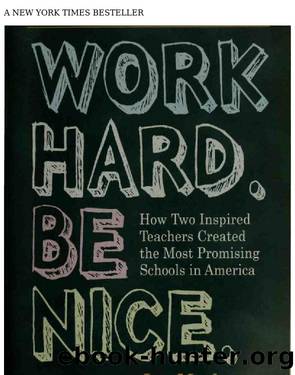Work hard. Be nice. : how two inspired teachers created the most promising schools in America by Mathews Jay 1945-

Author:Mathews, Jay, 1945-
Language: eng
Format: epub
Tags: http://www.archive.org/details/workhardbeniceho00math
Starting Again in Houston
Bus transportation from the Gulfton homes of Feinbergâs students to their new school at Askew Elementary was a problem. District policy was to punch in studentsâ addresses on the computer and choose street corners that served most of them. Many still had long walks to bus stops. Feinberg thought that could kill his program. It would be dark those mornings. His school was starting so early. He had promised his parents that the buses would be convenient.
He knew the building on McCarty Drive where the school district bus schedulers had their offices. He showed up one morning with breakfast taquitos for the entire staff and offered to help them get the new KIPP bus stop locations just right. âCould we put the computer on manual override?â he asked. âI would like to punch in my own times and locations.â The man in front of the computer, munching on his taquito, told Feinberg to go right ahead.
Askew was a kindergarten-through-fourth-grade school. The two-story brick building was fifty-six years old, with a dozen yellowish brown modular buildings clumped together in back. KIPP would use three of the modulars â a large one with space for two classrooms, a smaller one with space for one class, and a third with a two-hundred-square-foot storage room, which would serve as Feinbergâs office. Piles of broken furniture, old books, and cleaning equipment filled most of that space, but Feinberg managed to push them to one side. He had a desk and chair.
Unlike Levin in New York, Feinberg had gotten permission to
I
conduct a summer session. It was shorter than he wanted, just two weeks. It finished a week before the regular school year began. He still needed to arrange for lunches and a hundred other details. He pushed the FileMaker program on his Mac to the limit getting the paperwork ready for opening day. He wrote schedules and homeroom lists and letters to parents. His teachers tried to remove, or rearrange, the piles of debris in the previously occupied modulars. There was not much time for pedagogical debates or detailed lesson plans. Feinberg told his team to focus on essentials: âGet your classrooms ready, get your materials ready, tell me what you need, start doing your planning for what you are going to do when the kids get here. Those first couple of days weâre going to have them all together, and donât worry about it. I am going to take care of everything.â
As his teachers discovered, Feinbergâs idea of taking care of everything sometimes meant doing things they thought they had already done. Each night, after they went home exhausted, Feinberg slipped into their classrooms and made changes. Some of their posters were not, in his view, properly hung or well chosen. Some of the lettering on their bulletin boards was crooked. Feinberg knew he was going too far, but he could not control himself. He blamed Levin for his fixation on classroom arrangements. His friend demanded the best possible displays, as Ball had done.
Download
This site does not store any files on its server. We only index and link to content provided by other sites. Please contact the content providers to delete copyright contents if any and email us, we'll remove relevant links or contents immediately.
Hit Refresh by Satya Nadella(9082)
When Breath Becomes Air by Paul Kalanithi(8365)
The Girl Without a Voice by Casey Watson(7843)
A Court of Wings and Ruin by Sarah J. Maas(7727)
Do No Harm Stories of Life, Death and Brain Surgery by Henry Marsh(6905)
Shoe Dog by Phil Knight(5216)
The Rules Do Not Apply by Ariel Levy(4908)
A Higher Loyalty: Truth, Lies, and Leadership by James Comey(4905)
Hunger by Roxane Gay(4893)
Tuesdays with Morrie by Mitch Albom(4728)
Everything Happens for a Reason by Kate Bowler(4701)
The Immortal Life of Henrietta Lacks by Rebecca Skloot(4548)
Millionaire: The Philanderer, Gambler, and Duelist Who Invented Modern Finance by Janet Gleeson(4418)
How to Change Your Mind by Michael Pollan(4315)
All Creatures Great and Small by James Herriot(4268)
The Money Culture by Michael Lewis(4130)
Man and His Symbols by Carl Gustav Jung(4094)
Elon Musk by Ashlee Vance(4082)
Tokyo Vice: An American Reporter on the Police Beat in Japan by Jake Adelstein(3950)
